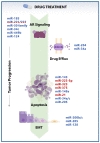MicroRNAs as Epigenetic Determinants of Treatment Response and Potential Therapeutic Targets in Prostate Cancer
- PMID: 34069147
- PMCID: PMC8156532
- DOI: 10.3390/cancers13102380
MicroRNAs as Epigenetic Determinants of Treatment Response and Potential Therapeutic Targets in Prostate Cancer
Abstract
Prostate cancer (PCa) is the second most common tumor in men worldwide, and the fifth leading cause of male cancer-related deaths in western countries. PC is a very heterogeneous disease, meaning that optimal clinical management of individual patients is challenging. Depending on disease grade and stage, patients can be followed in active surveillance protocols or undergo surgery, radiotherapy, hormonal therapy, and chemotherapy. Although therapeutic advancements exist in both radiatiotherapy and chemotherapy, in a considerable proportion of patients, the treatment remains unsuccessful, mainly due to tumor poor responsiveness and/or recurrence and metastasis. microRNAs (miRNAs), small noncoding RNAs that epigenetically regulate gene expression, are essential actors in multiple tumor-related processes, including apoptosis, cell growth and proliferation, autophagy, epithelial-to-mesenchymal transition, invasion, and metastasis. Given that these processes are deeply involved in cell response to anti-cancer treatments, miRNAs have been considered as key determinants of tumor treatment response. In this review, we provide an overview on main PCa-related miRNAs and describe the biological mechanisms by which specific miRNAs concur to determine PCa response to radiation and drug therapy. Additionally, we illustrate whether miRNAs can be considered novel therapeutic targets or tools on the basis of the consequences of their expression modulation in PCa experimental models.
Keywords: epigenetics; microRNA; prostate cancer; therapy.
Conflict of interest statement
The authors declare no conflict of interest.
Figures


Similar articles
-
Role of MicroRNAs in Treatment Response in Prostate Cancer.Curr Cancer Drug Targets. 2018;18(10):929-944. doi: 10.2174/1568009618666180315160125. Curr Cancer Drug Targets. 2018. PMID: 29644941 Free PMC article. Review.
-
MicroRNAs and the Response of Prostate Cancer to Anti-Cancer Drugs.Curr Drug Targets. 2016;17(3):257-65. doi: 10.2174/1389450116666150316223341. Curr Drug Targets. 2016. PMID: 25777275 Review.
-
MicroRNAs and epithelial-mesenchymal transition in prostate cancer.Oncotarget. 2016 Oct 11;7(41):67597-67611. doi: 10.18632/oncotarget.11708. Oncotarget. 2016. PMID: 27588490 Free PMC article. Review.
-
Targeting MicroRNAs in Prostate Cancer Radiotherapy.Theranostics. 2017 Jul 23;7(13):3243-3259. doi: 10.7150/thno.19934. eCollection 2017. Theranostics. 2017. PMID: 28900507 Free PMC article. Review.
-
miRNA in Prostate Cancer: New Prospects for Old Challenges.EJIFCC. 2014 Apr 28;25(1):79-98. eCollection 2014 Apr. EJIFCC. 2014. PMID: 27683458 Free PMC article.
Cited by
-
How gallic acid regulates molecular signaling: role in cancer drug resistance.Med Oncol. 2023 Sep 27;40(11):308. doi: 10.1007/s12032-023-02178-4. Med Oncol. 2023. PMID: 37755616 Review.
-
Advances in the Current Understanding of the Mechanisms Governing the Acquisition of Castration-Resistant Prostate Cancer.Cancers (Basel). 2022 Jul 31;14(15):3744. doi: 10.3390/cancers14153744. Cancers (Basel). 2022. PMID: 35954408 Free PMC article. Review.
-
Non-coding RNAs associated with autophagy and their regulatory role in cancer therapeutics.Mol Biol Rep. 2022 Jul;49(7):7025-7037. doi: 10.1007/s11033-022-07517-8. Epub 2022 May 10. Mol Biol Rep. 2022. PMID: 35534587 Review.
-
Molecular Mechanisms of Cancer Drug Resistance: Emerging Biomarkers and Promising Targets to Overcome Tumor Progression.Cancers (Basel). 2022 Mar 23;14(7):1614. doi: 10.3390/cancers14071614. Cancers (Basel). 2022. PMID: 35406386 Free PMC article.
-
Circulating microRNAs as biomarker in prostate cancer and their significance in the differentiation of benign and malignant conditions of the prostate.Urol Ann. 2025 Jul-Sep;17(3):192-200. doi: 10.4103/ua.ua_11_25. Epub 2025 Jul 18. Urol Ann. 2025. PMID: 40843406 Free PMC article.
References
-
- Mottet N., van den Bergh R.C.N., Briers E., van den Broeck T., Cumberbatch M.G., de Santis M., Fanti S., Fossati N., Gandaglia G., Gillessen S., et al. EAU-EANM-ESTRO-ESUR-SIOG Guidelines on Prostate Cancer—2020 Update. Part 1: Screening, Diagnosis, and Local Treatment with Curative Intent. Eur. Urol. 2021;79:243–262. doi: 10.1016/j.eururo.2020.09.042. - DOI - PubMed
-
- Bjurlin M.A., Carter H.B., Schellhammer P., Cookson M.S., Gomella L.G., Troyer D., Wheeler T.M., Schlossberg S., Penson D.F., Taneja S.S. Optimization of initial prostate biopsy in clinical practice: Sampling, labeling and specimen processing. J. Urol. 2013;189:2039–2046. doi: 10.1016/j.juro.2013.02.072. - DOI - PMC - PubMed
-
- Cornford P., van den Bergh R.C.N., Briers E., van den Broeck T., Cumberbatch M.G., de Santis M., Fanti S., Fossati N., Gandaglia G., Gillessen S., et al. EAU-EANM-ESTRO-ESUR-SIOG Guidelines on Prostate Cancer. Part II—2020 Update: Treatment of Relapsing and Metastatic Prostate Cancer. Eur. Urol. 2021;79:263–282. doi: 10.1016/j.eururo.2020.09.046. - DOI - PubMed
Publication types
Grants and funding
LinkOut - more resources
Full Text Sources

